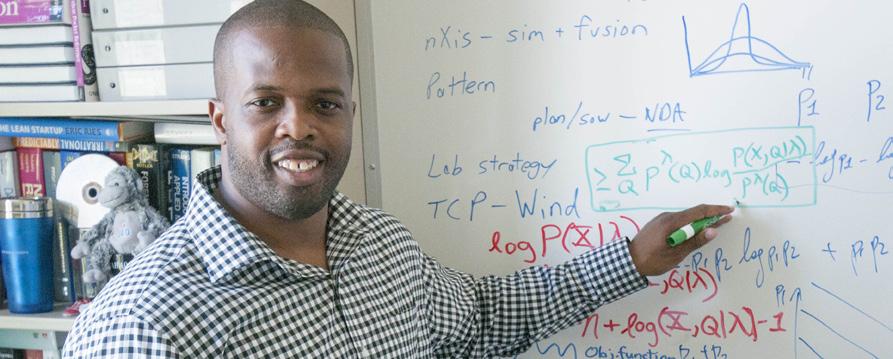
4 minute read
Here’s looking at You, Data Career
by Lango Deen ldeen@ccgmag.com

Brett Matthews is leading the way in data science and data analytics at GE. How did he become a data scientist? What did he study?
Developing industrial machines and devices that touch people’s lives are all in a day’s work for Brett Matthews and his team.
They make technology that power planes, trains, provide power for large and small grids all over the world. The technology they create also allows them to make our devices more energy efficient and environmentally friendly. “Our business partners usually come to us with some technical problem they’d like to solve,” Brett explains.
Those problems include increasing efficiency or safety, reducing costs or emissions, or detecting or preventing mechanical failures.
“These machines are equipped with many sensors—pressure transducers, vibration and acoustic sensors, arterial blood pressure,” he adds.
How does he do that?
Brett says his job is to use his professional background in digital signal processing, machine learning, and statistical pattern recognition to make machines smarter.
“I develop and apply digital signal processing and machine learning methods, which we call “analytics” on these signals to solve our businesses’ problems,” Brett says.
“My work usually involves getting large volumes of data from our business partners, conceiving mathematical and technical solutions, building those solutions in code, evaluating the solutions on data, and refining and improving,” he adds. “I typically write code in MATLAB, python, C/C++ and a few other languages.”
GE makes many types of machines. They run from large, jumbo-sized jet engines to locomotives, enormous wind turbines with blades more than the length of a football field, and heart monitoring devices about the size of a pack of chewing gum or a USB memory stick.
How can you prepare for his job?
“In terms of education, I have a Bachelor of Science, Master of Science, and a Ph.D., all in electrical and computer engineering,” Brett says.
“Someone looking to do this job should have a background doing research in some Data Science-related area,” he advises.
Brett gets to work on important, challenging projects. He also gets to be at the cutting edge of technology in GE Digital.
As a lead research engineer, he is one of the many scientists and engineers in the Software, Sciences, and Analytics division of GE’s Global Research Center, who come up with advanced solutions to serve the needs of GE’s business units in aviation, healthcare, energy, and transportation.
DATA SCIENCE AREAS:
1. Statistical signal processing 2. Machine learning 3. Applied statistics 4. Operations research 5. Mathematics or statistical natural language processing
“Often people in related fields like physics have skills that apply here as well,” he adds.
• Brooklyn Technical High School, 1996 • B.S. in Computer & Systems Engineering, Rensselaer Polytechnic Institute, 2001 • M.S., Electrical, and Computer Engineering, Georgia Institute of Technology, 2003 • Ph.D. Electrical and Computer Engineering, Georgia Institute of Technology, 2012
How he got to become a data scientist?
As Brett was nearing the end of his Ph.D. program and seeking jobs, most opportunities he saw for someone with his background were in academia, government defense labs, or Wall Street, he recalled.
“Ideally, I wanted a job where I could do state-of-the-art research in machine learning and signal processing, but also apply it to real problems, and also have the freedom to try new things,” he said. “I really didn’t know such a job existed, and that’s exactly what this job turned out to be,” he said. “My job at the research center is actually the dream job that I didn’t know existed.”
Brett joined GE after finishing his Ph.D. program, about 4 years ago. It was his first full-time position, but he had chalked up 10 internships at Lucent Technologies (1), Sikorsky Aircraft (2), Texas Instruments (3), IBM TJ Watson Research Center (3), and MIT Lincoln Labs (1)as an undergrad and a grad student. “I got involved in Internet of Things (IoT) work, mainly through my current job at GE Global Research,” Brett said. “Although I was always interested in signal processing and machine learning, my job at GE involves working on many machines, which benefit from remote monitoring and diagnostics, a natural problem for IoT work and research.”
Most of the people who work at GE’s Global Research Center have Ph.D.’s, but many others come through the Edison program, which requires a master’s degree at the entry level.
The GE Edison Engineering Development Program is a two- to threeyear early career program consisting of three or more rotational assignments. Participants have the opportunity to earn credit towards an M.S. degree in engineering or other real world application technologies. You’ll receive education and mentorship from the top minds in your field while working on high-profile projects driven by real GE business priorities.
“I think it is very important to be a mentor and to have mentors in our careers, as well,” Brett says.
“I actively participate in GE’s African-American Forum (AAF), which is an affinity group for African-American employees at GE. AAF gives me the opportunity to meet other GE employees, who have become mentors to me, and to mentor students at universities, through recruiting. While it can be difficult to find time, meeting with someone for a couple of hours or so, monthly or quarterly, is definitely manageable,” he recommends. Brett’s job requires a lot of work and he says frustrating setbacks happen all the time.
“Overcoming these challenges is a big part of the fun, so it all balances out,” he says. S
If you are ready, visit http//www.ccgjobmatch.com Let us help you! Post job openings Connect with qualified candidates Become a featured employer CALLING ALL EMPLOYERS







